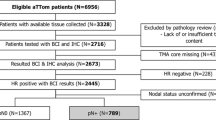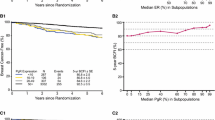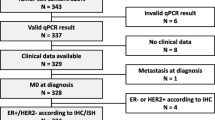Abstract
Recent ASCO/CAP guidelines focus on decision making associated with the presence/absence of continuous breast biomarkers. Statistical standardization (SS) is demonstrated as a method to evaluate the effects of continuous RT-PCR biomarker expression levels on breast cancer outcomes. MA.14 allocated 667 postmenopausal patients to tamoxifen based on locally determined ER/PR. Of 299 available patient tumor samples, 292 passed internal quality control. All tumors were centrally assessed by RT-PCR ER/PR/HER2 with each biomarker’s z-scores categorized: ≥1.0 standard deviation (SD) below mean; <1.0 SD below mean; ≤1.0 SD above mean; >1.0 SD above mean. Log-rank statistics tested univariate differences in breast cancer relapse-free survival (RFS). Continuous SS-ER/PR/HER2 were assessed in multivariate Cox step-wise forward regression, adding a factor if p ≤ 0.05. Sensitivity analyses examined an external HER2+ cut-point of 1.32. Patients whose tumors were tested were representative of the MA.14 population (p values = 0.18–0.90). At 9.8 years median follow-up, SS-ER did not univariately impact RFS (p = 0.31). SS-PR values above the mean (z ≥ 0.0) had the best univariate RFS (p = 0.03). SS-HER2 also univariately impacted RFS (p = 0.004) with lowest (z-scores ≤ −1.0) and highest (z-scores > 1.0) having shortest RFS. Multivariate stratified/unstratified Cox models indicated patients with T1 tumors (p = 0.02/p = 0.0002) and higher SS-PR (p = 0.02/p = 0.01) had longer RFS; node-negative patients had better RFS (in unstratified analysis, p < 0.0001). Local ER/PR status did not impact RFS (p > 0.05). Patients with SS HER2+ ≥ 1.32 had worse RFS (univariate, p = 0.05; multivariate, p = 0.06). We demonstrated that higher SS-PR, and SS HER2 levels, measured by RT-PCR impacted breast cancer RFS outcomes. Evaluation in other trials may provide support for this methodology.





Similar content being viewed by others
References
Hammond MEH, Hayes DF, Dowsett M, Allred DC, Hagerty KL, Badve S, Fitzgibbons PL, Francis G, Goldstein NS, Hayes M, Hicks DG, Lester S, Love R, Mangu PB, McShane L, Miller K, Osborne CK, Paik S, Perlmutter J, Rhodes A, Sasano H, Schwartz JN, Sweep FCG, Taube S, Torlakovic EE, Valenstein P, Viale G, Visscher D, Wheeler T, Williams RB, Wittliff JL, Wolff AC (2010) American Society of Clinical Oncology/College of American Pathologists guideline recommendations for immunohistochemical testing of estrogen and progesterone receptors in breast cancer. J Clin Oncol 28:2784–2795. doi:10.1200/JCO.2009.25.6529
Wolff AC, Hammond MEH, Schwartz JN, Hagerty KL, Allred DC, Cote RJ, Dowsett M, Fitzgibbons PL, Hanna WM, Langer A, McShane LM, Paik S, Pegram MD, Perez EA, Press MF, Rhodes A, Sturgeon C, Taube SE, Tubbs R, Vance GH, van de Vijver M, Wheeler TM, Hayes DF (2007) American Society of Clinical Oncology/College of American Pathologists guideline recommendations for human epidermal growth factor receptor 2 testing in breast cancer. J Clin Oncol 25:118–145. doi:10.1200/JCO.2006.09.2775
Woolff AC, Hammond MEH, Hicks DG, Dowsett M, McShane LM, Allison KH, Allred DC, Bartlett JMS, Bilous M, Fitzgibbons P, Hanna W, Jenkins RB, Mangu PB, Paik S, Perez EA, Press MF, Spears PA, Vance GH, Viale G, Hayes DF (2013) Recommendations for human epidermal growth factor receptor 2 testing in breast cancer: American Society of Clinical Oncology/College of American Pathologists Clinical Practice Guideline Update. J Clin Oncol 31:3997–4014. doi:10.1200/JCO.2013.50.9984
Chapman JAW, Nielsen TO, Ellis MJ, Bernard P, Chia S, Gelmon KA, Pritchard KI, Le Maitre A, Goss PE, Leung S, LE Shepherd (2013) Effect of continuous statistically standardized measures of estrogen and progesterone receptors on disease-free survival in NCIC CTG MA.12 Trial and BC Cohort. BCR 15:R71. doi:10.1186/bcr3465
Pritchard KI, Shepherd LE, Chapman JAW, Norris BD, Cantin J, Goss PE, Dent SF, Walde D, Vandenberg TA, Findlay B, O’Reilly SE, Wilson CF, Han L, Piura E, Whelan TJ, Pollak MN (2011) Randomized trial of tamoxifen versus combined tamoxifen and octreotide LAR therapy in the adjuvant treatment of early-stage breast cancer in postmenopausal women: NCIC CTG MA.14. J Clin Oncol 29:3869–3876. doi:10.1200/JCO.2010.33.7006
Pollak MN, Chapman JAW, Pritchard KI, Krook JE, Dhaliwal HS, Vandenberg TA, Whelan TJ, O’Reilly SE, Wilson CF, LE Shepherd (2010) Tamoxifen versus tamoxifen plus octreotide LAR as adjuvant therapy for early stage breast cancer in postmenopausal women: update of NCIC CTG MA14 trial. J Clin Oncol 28:15s (suppl; abstr 542)
Sgroi DC, Carney E, Zarrella E, Steffel L, Binns SN, Finkelstein DM, Szymonifka J, Bhan AK, Shepherd LE, Zhang Y, Schnabel CA, Erlander MG, Ingle JN, Porter P, Muss HB, Pritchard KI, Tu D, Rimm DL, Goss PE (2013) Prediction of late disease recurrence and extended adjuvant letrozole benefit by the HOX13/IL17BR biomarker. J Natl Cancer Inst 105:1036–1042. doi:10.1093/jnci/djt146
Chapman JW, Mobbs BG, McCready DR, Lickley HLA, Trudeau ME, Hanna W, Kahn HJ, Sawka CA, Fish EB, Pritchard KI (1996) An investigation of cut-points for primary breast cancer oestrogen and progesterone receptor assays. J Steroid Biochem Mol Biol 57:323–328
Chapman JW, Mobbs BG, Hanna W, Kahn HJ, Murray D, Lickley HLA, Fish EB, Trudeau ME, Miller NA, McCready DR (2000) A changing role for steroid hormone receptors in primary breast cancer? In: Current topics in steroid research. Research Trends, Trivandrim, India, vol 3, pp 39–51
Chapman JW, Lickley HLA, Trudeau ME, Hanna WM, Kahn HJ, Murray D, Sawka CA, Mobbs BG, McCready DR, Pritchard KI (2006) Ascertaining prognosis for breast cancer in node-negative patients with innovative survival analysis. Breast J 12:37–47. doi:10.1111/j.1075-122X.2006.00183.x
Perez EA, Baehner FL, Butler SM, Thompson FA, Dueck AC, Jamshidian F, Cherbavaz D, Yoshizawa C, Shak S, Kaufman PA, Davidson NE, Gralow J, Asmann YW, Ballman KV (2015) The relationship between quantitative human epidermal growth factor receptor 2 gene expression by the 21-gene reverse transcriptase polymerase chain reaction assay and adjuvant trastuzumab benefit in Alliance N9831. Breast Cancer Res 17:133. doi:10.1186/s13058-015-0643-7
Paik S, Kim C, Wolmark N (2008) HER2 status and benefit from adjuvant trastuzumab in breast cancer. N Engl J Med 358:1409–1411. doi:10.1056/NEJMc0801440
Goss PE, Ingle JN, Pritchard KI, Ellis MJ, Sledge GW, Budd GT, Rabaglio M, Ansari RH, Johnson DB, Tozer R, D’Souza DP, Chalchal H, Spadafora S, Stearns V, Perez EA, Liedke PER, Lang I, Elliott C, Gelmon KA, Chapman JW, Shepherd LE (2013) Exemestane versus anastrozole in postmenopausal women with early breast cancer: NCIC CTG MA.27—a randomized controlled phase III trial. J Clin Oncol 31:1398–1404. doi:10.1200/JCO.2012.44.7805
Acknowledgments
This study was funded by the Avon Foundation (PEG, DCS). MA.14 was supported by Grant No. 16512 from Canadian Cancer Society Research Institute (MNP), and a grant from Novartis Pharmaceuticals Canada (MNP). The Canadian Cancer Society supports the work of the NCIC Clinical Trials Group through a program grant from the Canadian Cancer Society Research Institute. Paul Goss is funded in part by the Avon Foundation, New York.
Author information
Authors and Affiliations
Corresponding author
Ethics declarations
Conflicts of Interest
YZ and CAS were paid and have stock ownership in bioTheranostics, Inc.; ME had a consultant/advisory role in bioTheranostics, Inc.; TB-C has been paid by Roche. No other authors have conflicts to disclose.
Electronic supplementary material
Below is the link to the electronic supplementary material.
Rights and permissions
About this article
Cite this article
Chapman, JA.W., Sgroi, D.C., Goss, P.E. et al. Relapse-free survival of statistically standardized continuous RT-PCR estrogen receptor (ER), progesterone receptor (PR), and human epidermal growth factor receptor 2 (HER2): NCIC CTG MA.14. Breast Cancer Res Treat 157, 101–108 (2016). https://doi.org/10.1007/s10549-016-3806-z
Received:
Accepted:
Published:
Issue Date:
DOI: https://doi.org/10.1007/s10549-016-3806-z




